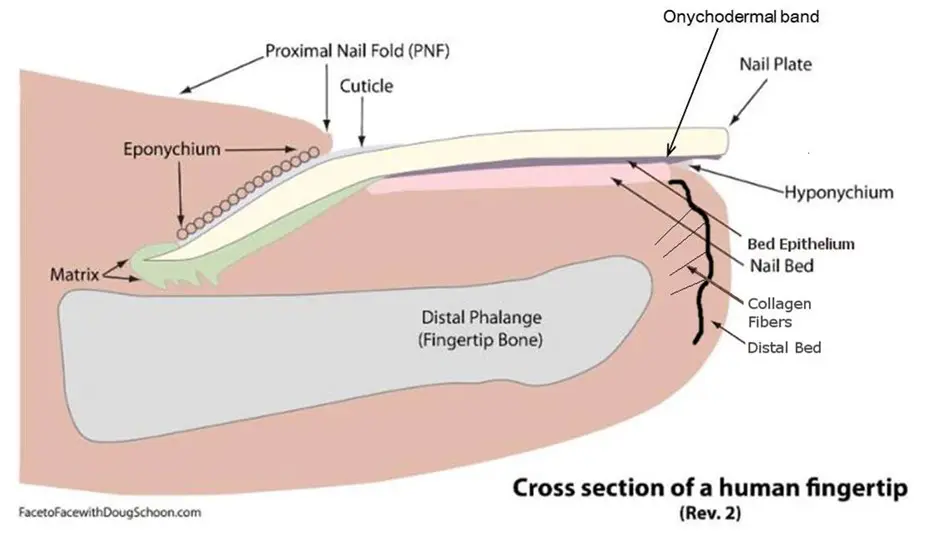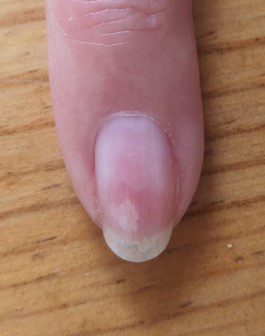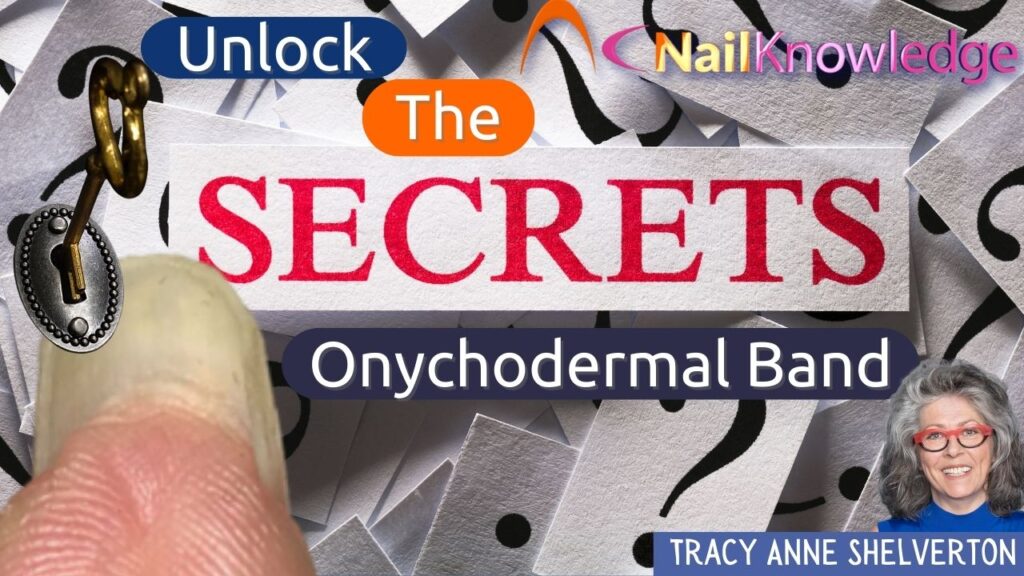A faixa onicodérmica
We see it every day while we’re at work, but do we really know what it is? Let’s take a closer look at Doug Schoon’s illustration to get a better understanding.

If we attempt to view it from behind the free edge, it appears like this:

• The Onychodermal Band is non-living tissue. It’s an extension of the bed epithelium.
• It has a gray-brownish color.
A faixa onicodérmica: Uma barreira protetora oculta
Entre os placa ungueal and the nail bed lies the bed epithelium. When the bed epithelium reaches the end of the leito ungueal e se dobra sobre si mesmo, ele se torna a faixa onicodérmica. Esse tecido estreito e compactado atua como uma barreira patogênica extra sob a camada livre de borda da placa ungueal. Ela forma uma parceria com a hiponíquio and together they become a super seal – it often goes unnoticed and is nearly invisible. You have to look closely to perceive it.
A faixa onicodérmica é um pouco translúcida, uma fina camada abaixo da borda distal (borda livre) da placa unguealA cor da unha é a mesma que a do cotovelo, abrangendo toda a largura da placa ungueal e delimitando o branco visível da borda livre.
A faixa onicodérmica serve para evitar que os menores organismos infecciosos e contaminantes se infiltrem no leito ungueal. Se esse tecido protetor (barreira patogênica) for rompido, a unha A placa se separa do leito ungueal causing onycholysis and dramatically increasing the risk of infection.
Its partner in the nail unit is the Hyponychium and that hyponychium is one of the four guardian seals of the nail unit, designed to protect the leito ungueal from germs and other infections, such as fungus or yeast. While the hiponíquio is composed of living epidermal tissue. It’s important to note that the Onychodermal Band is non-living tissue and needs to remain elastic to perform its job effectively.
Aumentando a elasticidade: Aplicação de óleo atrás da borda livre para a saúde das unhas
Aplicação de óleo A aplicação de um adesivo de unha na parte de trás da borda livre, em vez de na parte superior da placa ungueal, pode ajudar a manter a elasticidade necessária, mesmo que a faixa onicodérmica já tenha se descolado.
Medidas de precaução e considerações autoimunes para o cuidado com as unhas
Cuidado ao usar um Efile para encurtar a unha que está saindo de um aprimoramento de unhas behind the free edge or if you use a sharp instrument to clean under the free edge, might accidentally damage it, and you’ll immediately see the consequences as onycholysis.
Algumas doenças autoimunes também podem ter um impacto:
• Psoriasis
• Lichen Planus
• Eczema
Todas essas são doenças que podem afetar a faixa onicodérmica, a matriz da unha, a placa ungueal ou o leito ungueal, o que faz com que o selo se rompa. A aplicação de óleo atrás da borda livre é fundamental, pois o óleo repele a água, mantém o selo de proteção elástico e não fornece uma fonte de nutrição para os germes, oferecendo excelente proteção.
In this image, you can clearly see how psoriasis can affect it. When the ‘oil slick’ blister forms, the bed epithelium is directly affected by the upwards pressure of the blister dislodging it from the nail bed. As the nail plate moves (perpetual motion) and the damaged bed epithelium gets closer to the free edge onycholysis is a fact and the nail bed is exposed to any and all pathogens.

Sometimes, you may also notice that the hyponychium is pulled along with the Onychodermal Band. Something simple (but not always noticed) like product shrinkage can easily cause this to happen. If you recognize this happening, stop with your nail product until the hyponychium is recovered or find a more flexible product. Here, too, a good quality oil is your friend. If you work with a cuticle pusher or an e-file in this area, you’re likely to cause more irritation.
The Onychodermal Band is of utmost importance for the overall health of the nail unit and must be treated with care. Being cautious during cleaning under the free edge is necessary. It’s better to clean with a soft brush and oil, always avoiding sharp objects under the free edge to keep the nail unit healthy.
Em conclusão
The Onychodermal Band may go unnoticed in our daily lives, but it plays a crucial role in protecting our nails from infections and maintaining their overall health. Understanding its function and how to care for it is essential for nail health and hygiene. So, next time you’re working on your nails, remember the significance of the Onychodermal Band and treat it with the care it deserves to keep your nails looking and feeling their best.


